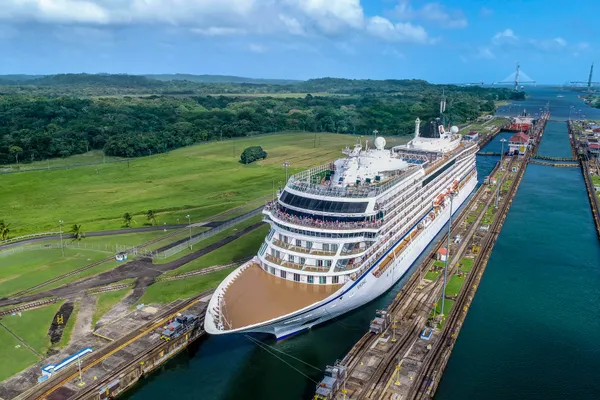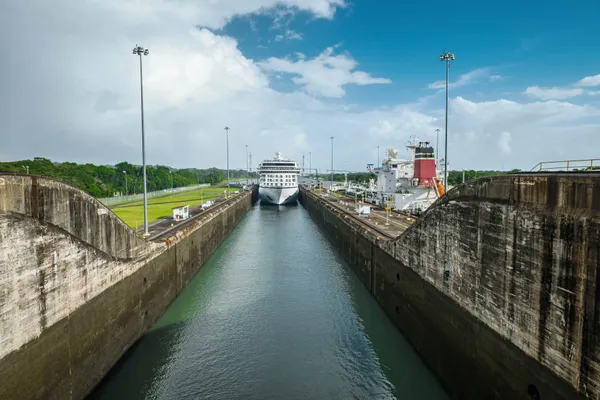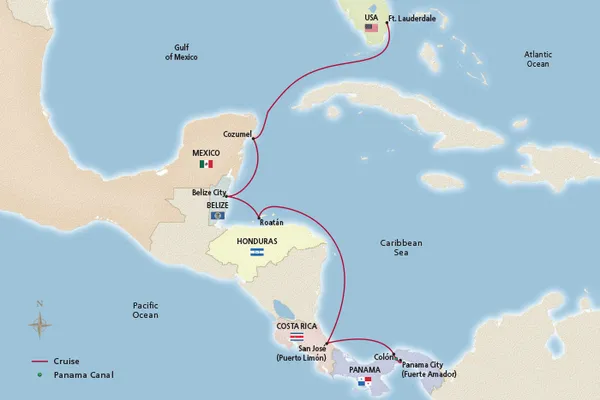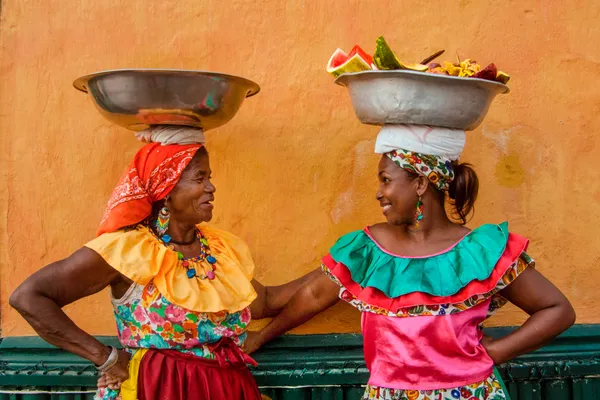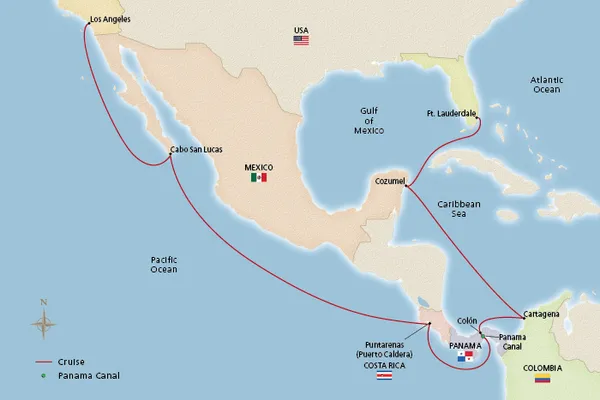
Traverse the legendary Panama Canal
The Panama Canal stands as one of the most extraordinary engineering achievements in modern history. Read on to learn more about how it connected cultures and commerce from around the world. Plus, delve into three popular Panamanian dishes, discover the traditions of the Indigenous Emberá people and enhance your knowledge of how the canal’s locks work.

Panama Canal
Conceived as a desirable alternative to the time-consuming and often treacherous voyages around South America’s Cape Horn, the Panama Canal has revolutionized global trade and maritime travel since it opened in August 1914. The construction of this 51-mile (82 km) waterway across the Isthmus of Panama was a massive undertaking. More than 40,000 men and women worked on the project, which took a decade to complete.
The French were the first to attempt building a canal between the Pacific and Atlantic Oceans in the late 19th century. Led by Ferdinand de Lesseps, who previously built the Suez Canal in Egypt, excavation in Panama began in 1880. However, engineering challenges, disease and poor labor conditions forced the French to abandon the project after nine years. The US took over construction in 1904 and implemented new sanitation measures, as well as innovative excavation techniques designed by chief engineer John Stevens.
Originally, the canal was intended to be built through Nicaragua, but Panama was chosen due to the advocacy of US President Theodore Roosevelt and French engineer Philip-Jean Bunau-Varilla, who both favored Panama’s topography over the more mountainous Nicaragua. To create an additional water source for the canal, the Chagres River was dammed to form Gatun Lake, which spans 166 sq mi. (430 sq km). During dry periods, water is taken from the artificial lake to fill the canal. In total, the US spent approximately $375 million on the project (the equivalent of about $10 billion in today’s economy).
Today, the Panama Canal serves as a vital conduit for global trade, handling around 12 percent of the world’s maritime commerce. On average, it takes a ship 8–10 hours to transit the canal, and an intricate system of locks raises and lowers each ship during the journey. An estimated 13,000 vessels transit the canal per year, generating around $2.6 billion in annual tolls and fees. The canal’s third set of locks, added in 2016, accommodates larger vessels. Ships traveling between the east and west coast of the US save about 8,000 nautical mi. (15,000 km) by using the famed shortcut.
As it enters its second century of operation, the Panama Canal remains a remarkable testament to human determination and innovation.

-
Cuisine—Three classic Panamanian dishes
As an international crossroads, Panama’s cuisine reflects the diversity of its people. A vibrant fusion of Indigenous, Spanish and Afro-Caribbean influences, the country’s dishes offer a rich variety of flavors and textures. Here are three staples of classic Panamanian cuisine:
- Sancocho de Gallina
This rich, hearty stew is Panama’s national dish. Large pieces of chicken are simmered with starchy vegetables like potatoes, yuca or plantains, creating a savory broth. The star ingredient is culantro, a distinctive herb that is slightly sweeter and stronger in flavor than cilantro. Sancocho de gallina is often served alongside rice or fried plantains. - Patacones
Patacones are a popular side dish or appetizer made from twice-fried slices of green plantain. Similar to another Latin American favorite, tostones, these simple and versatile treats can be eaten on their own or paired with ketchup, mayonnaise or another sauce. - Carimañolas
A perfect afternoon snack, carimañolas are fritters made from mashed yuca dough and filled with a savory, spiced meat or cheese filling. Fried to a golden brown, these crunchy hand-held treats are street-food favorites throughout Panama.
- Sancocho de Gallina
-
Culture—The Emberá
The Emberá are one of seven Indigenous groups in Panama, comprising approximately 7.5 percent of the country’s total population. Traditionally, they lived in the Darién Rainforest, but during the 1960s, new, more densely populated Emberá villages were established in the Panama Canal watershed, along the banks of the Chagres River and Lake Gatun.
The Emberá people have preserved their traditions over the course of centuries. They share a deep reverence for rivers and forests, believing that everything in nature has a spirit. Their riverside environment figures prominently in daily activities like fishing, bathing and domestic chores. It also provides essential resources, such as fish and plantains, which are staples of the Emberá diet.
Most Emberá live with their extended family in round, open-air dwellings elevated on stilts. The floors are typically made from the bark of the jira palm, while the roofs are thatched from palm leaves.
The Emberá people wear little clothing but paint elaborate patterns on their bodies using the black dye of the jagua plant. In addition to its decorative and cultural purposes, this dye is also believed to repel insects.
Today, tourism helps support Emberá communities, and they are eager to share their culture and way of life with visitors. Guests may hear the traditional Emberá language, experience a traditional body painting session, watch a ceremonial dance performance or see artisans at work. Emberá craftspeople are especially known for their coiled baskets woven from black palm leaves. Some also carve cocobolo wood and ivory palm seeds into intricate statues and miniatures.
-
Science—The locks of the Panama Canal
The Panama Canal famously connects the Atlantic and Pacific Oceans via the Isthmus of Panama. While simple enough in principle, its construction stands as one of the greatest engineering marvels of the 20th century.
Given that the Atlantic Ocean sits at a lower sea level than the Pacific, engineers developed an intricate lock system to raise ships 85 ft. (26 m) above sea level. Vessels then continue their journey across Gatun Lake before reaching more locks that lower them back down to the correct elevation.
When a ship enters from the Atlantic Ocean, it passes through the first of three Gatun Locks. In a nearby control tower, the operator closes the miter gates and lower lock valves, then opens the upper valves. Powered by gravity, water from Gatun Lake—around 26.7 million gallons—rushes into the chamber, raising the ship. Within eight minutes, the first lock is full. This process repeats two more times until the vessel becomes level with Gatun Lake.
The ship then travels through the Culebra Cut, an excavated valley that crosses the Continental Divide, before passing through the Pedro Miguel Locks and the Miraflores Locks. The process is reversed, draining water away from the chambers to lower the ship back to sea level. The final stretch of the canal is a 7-mile (11.3 km) passage leading to the Pacific.
Only small vessels are allowed to pass through the locks unassisted. Larger ships are guided by electric locomotives known as mulas that follow cog tracks along the locks’ walls. This ensures that the ships are safely centered in the locks.
Panama Canal Highlights
Discover the “Path Between the Seas” as you explore the heart of the Caribbean and Central America. Here is a preview of some of the remarkable sights and activities you may experience on an ocean voyage through this remarkable region:
- Snorkel in the turquoise waters of the Caribbean
- Watch for monkeys and sloths in the Gamboa rainforest
- Traverse the Panama Canal, a marvel of engineering
- Hand-feed hummingbirds at Jamaica’s Rocklands Bird Sanctuary
- Explore Panama City’s Old Town, a UNESCO World Heritage Site
- Discover the traditions of Panama’s Indigenous Emberá people
- Learn how to prepare traditional Costa Rican cuisine
- Visit an artisan chocolate factory in Honduras
- Tour the ruins of Altun Ha, one of Belize's ancient temples
- Attend a mezcal masterclass in Cozumel
Panama Canal Travel FAQ
All-Inclusive Itineraries—Panama Canal
Choose one of our enriching, all-inclusive voyages and discover the many benefits of exploring in Viking comfort.



